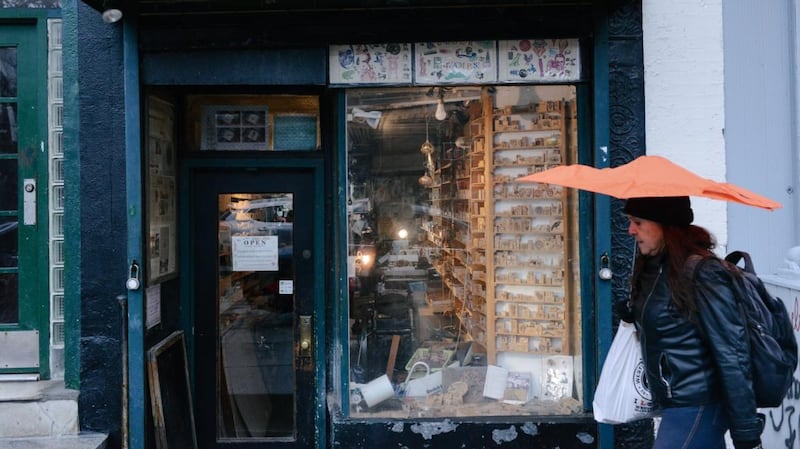There’s a Christmas Eve party every year in New York’s East Village, a gathering of strangers, customers, neighbours and friends invited to share libations and perhaps a party piece, in the unlikeliest of surroundings.
They meet in a hole-in-the-wall shop on East 11th Street, Casey Rubber Stamps, which sells rubber stamps of the type used to authenticate documents. It's a haphazard, cramped space, but one that now features in a score of tourist guides.
The proprietor, John Casey (69), a native of Millstreet, Co Cork, hates Christmas, proving his dislike for this time of year with a "Bah humbug" sign strung across his desk.
Nevertheless, Casey keeps the tradition going. His business began not in New York but in Millstreet six decades ago, inspired by his father’s dance hall. Today, he keeps the tradition alive in the city that never sleeps as a new decade nears.
“I don’t like Christmas, but the very first year I had a store, my very first Christmas, I was only here two months,” he says in his shop, which is cluttered with stamp-making equipment and myriad stamp designs.
“I was broke; I had no money for the supplies I needed; and about seven o’clock in the evening, somebody came in and brought a bottle of Baileys Irish Cream.
“We opened it, and then the next person came in. We gave them a glass of Baileys, and the next person, all of a sudden, went out to the liquor store, bought a bottle of wine and, before I knew it, I had a full-fledged party in my store.

“So every year, I have a Christmas party in the store in memory of that. I have two parties in the store every year: Christmas Eve and Patrick’s Day.” The parties, he said, offer “whiskey and beer – not any food”.
Casey adds: “The store is small, so we kind of stuff people in . . . Some people come early; they’re going away for the weekend, they’re going away for Christmas. They’ll just have one drink. Some people will come by and stay.
“On occasion, we’ve had strangers walk in the door and have a good time. You can recite a poem, sing a song.”
Interest piqued
Today, the rubber-stamp industry is waning, but Casey’s interest was first piqued his interest as the child of a Millstreet builder and farm owner who also ran the Maple dance hall.
“I got into coins very young – five or six years of age,” he said. “My father had a dance hall, and he used to go to the print shop to get posters made.”
The shop made a rubber stamp of one of his coins: “I thought the idea of turning this black-and-white image of a coin into something you could actually use as a stamp was just incredible.”
Casey wasn't successful until about 1979 – he warns that he's not good with dates – when he bought up equipment cheaply and began selling self-made stamps at a market on Bleecker Street in Manhattan, later on 7th Avenue.
He went back to Ireland for five years in the 1990s and tried to get a a stamp enterprise going, but it never took off and was plagued by everything from a port strike to a warehouse fire. So Casey returned to New York.
Today, he operates from his tiny store in the East Village, now a neighbourhood stalwart amid the continually rising rents in the city.
“The rubber stamp, as a commercial business, has contracted considerably in the last 20 years,” he said. “There used to be 15 to 20 rubber stamp stores in Manhattan; I think it’s down to about two.”
Now, however, his rarity is a plus.
“People come to New York, and I’m on their bucket list to visit as a small store. I get a lot of Taiwanese and a fair amount of Japanese. I’m in two Taiwanese and two Korean tourist guides to New York. I think I’m in two German guides and I know I’m in another one, too.”
Even in this digital age, Casey says some people are rediscovering the beauty of rubber stamps.
“It’s a funny thing: when the computer started to come in big, I had people say to me, ‘Oh, the computers will put you out of business.’ I knew intuitively that they weren’t,” he says.
“Some of my better customers are the computer people that are into graphics. There’s a different feel; there’s a different tactile aspect to rubber stamps that you don’t get with a computer, and people love that.
“Sometimes, I have a grandpa walk in with a kid, and the kid will look in the window and say, ‘Oooh, what do people use these for? People will use these?’ Then they go out buying half a dozen stamps.”
















